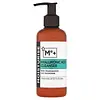What's inside
What's inside
 Key Ingredients
Key Ingredients

 Benefits
Benefits

 Concerns
Concerns

 Ingredients Side-by-side
Ingredients Side-by-side

Water
Skin ConditioningCaprylic/Capric Triglyceride
MaskingGlycerin
HumectantCetyl Esters
EmollientSorbitan Stearate
EmulsifyingStearyl Alcohol
EmollientTheobroma Cacao Seed Butter
EmollientCetyl Alcohol
EmollientPolysorbate 60
EmulsifyingGlycolic Acid
BufferingButyrospermum Parkii Butter
Skin ConditioningSodium Hydroxide
BufferingPolyacrylamide
Lactic Acid
BufferingC13-14 Isoparaffin
EmollientPhenoxyethanol
PreservativeParfum
MaskingVaccinium Myrtillus Fruit Extract
Skin ConditioningAllantoin
Skin ConditioningXanthan Gum
EmulsifyingLaureth-7
EmulsifyingSaccharum Officinarum Extract
MoisturisingCaprylhydroxamic Acid
Citric Acid
BufferingDisodium EDTA
Methylpropanediol
SolventCitrus Aurantium Dulcis Fruit Extract
MaskingCitrus Limon Fruit Extract
MaskingAcer Saccharum Extract
Skin ConditioningMalic Acid
BufferingCitronellol
PerfumingTartaric Acid
BufferingWater, Caprylic/Capric Triglyceride, Glycerin, Cetyl Esters, Sorbitan Stearate, Stearyl Alcohol, Theobroma Cacao Seed Butter, Cetyl Alcohol, Polysorbate 60, Glycolic Acid, Butyrospermum Parkii Butter, Sodium Hydroxide, Polyacrylamide, Lactic Acid, C13-14 Isoparaffin, Phenoxyethanol, Parfum, Vaccinium Myrtillus Fruit Extract, Allantoin, Xanthan Gum, Laureth-7, Saccharum Officinarum Extract, Caprylhydroxamic Acid, Citric Acid, Disodium EDTA, Methylpropanediol, Citrus Aurantium Dulcis Fruit Extract, Citrus Limon Fruit Extract, Acer Saccharum Extract, Malic Acid, Citronellol, Tartaric Acid
Water
Skin ConditioningCetearyl Alcohol
EmollientGlycerin
HumectantCeteareth-20
CleansingCetyl Alcohol
EmollientNiacinamide
SmoothingPhenoxyethanol
PreservativeBehentrimonium Methosulfate
Xanthan Gum
EmulsifyingTetrasodium Glutamate Diacetate
Ethylhexylglycerin
Skin ConditioningSodium Hyaluronate Crosspolymer
HumectantCitric Acid
BufferingSodium Lauroyl Lactylate
EmulsifyingPentylene Glycol
Skin ConditioningSodium Hydroxide
BufferingCeramide NP
Skin ConditioningCholesterol
EmollientCeramide AP
Skin ConditioningPhytosphingosine
Skin ConditioningCarbomer
Emulsion StabilisingCeramide EOP
Skin ConditioningWater, Cetearyl Alcohol, Glycerin, Ceteareth-20, Cetyl Alcohol, Niacinamide, Phenoxyethanol, Behentrimonium Methosulfate, Xanthan Gum, Tetrasodium Glutamate Diacetate, Ethylhexylglycerin, Sodium Hyaluronate Crosspolymer, Citric Acid, Sodium Lauroyl Lactylate, Pentylene Glycol, Sodium Hydroxide, Ceramide NP, Cholesterol, Ceramide AP, Phytosphingosine, Carbomer, Ceramide EOP
 Reviews
Reviews

Ingredients Explained
These ingredients are found in both products.
Ingredients higher up in an ingredient list are typically present in a larger amount.
Cetyl Alcohol is a fatty alcohol. Fatty Alcohols are most often used as an emollient or to thicken a product.
Its main roles are:
Though it has "alcohol" in the name, it is not related to denatured alcohol or ethyl alcohol.
The FDA allows products labeled "alcohol-free" to have fatty alcohols.
Learn more about Cetyl AlcoholCitric Acid is an alpha hydroxy acid (AHA) naturally found in citrus fruits like oranges, lemons, and limes.
Like other AHAs, citric acid can exfoliate skin by breaking down the bonds that hold dead skin cells together. This helps reveal smoother and brighter skin underneath.
However, this exfoliating effect only happens at high concentrations (20%) which can be hard to find in cosmetic products.
Due to this, citric acid is usually included in small amounts as a pH adjuster. This helps keep products slightly more acidic and compatible with skin's natural pH.
In skincare formulas, citric acid can:
While it can provide some skin benefits, research shows lactic acid and glycolic acid are generally more effective and less irritating exfoliants.
Most citric acid used in skincare today is made by fermenting sugars (usually from molasses). This synthetic version is identical to the natural citrus form but easier to stabilize and use in formulations.
Read more about some other popular AHA's here:
Learn more about Citric AcidGlycerin is already naturally found in your skin. It helps moisturize and protect your skin.
A study from 2016 found glycerin to be more effective as a humectant than AHAs and hyaluronic acid.
As a humectant, it helps the skin stay hydrated by pulling moisture to your skin. The low molecular weight of glycerin allows it to pull moisture into the deeper layers of your skin.
Hydrated skin improves your skin barrier; Your skin barrier helps protect against irritants and bacteria.
Glycerin has also been found to have antimicrobial and antiviral properties. Due to these properties, glycerin is often used in wound and burn treatments.
In cosmetics, glycerin is usually derived from plants such as soybean or palm. However, it can also be sourced from animals, such as tallow or animal fat.
This ingredient is organic, colorless, odorless, and non-toxic.
Glycerin is the name for this ingredient in American English. British English uses Glycerol/Glycerine.
Learn more about GlycerinPhenoxyethanol is a preservative that has germicide, antimicrobial, and aromatic properties. Studies show that phenoxyethanol can prevent microbial growth. By itself, it has a scent that is similar to that of a rose.
It's often used in formulations along with Caprylyl Glycol to preserve the shelf life of products.
Sodium Hydroxide is also known as lye or caustic soda. It is used to adjust the pH of products; many ingredients require a specific pH to be effective.
In small amounts, sodium hydroxide is considered safe to use. However, large amounts may cause chemical burns due to its high alkaline.
Your skin has a natural pH and acid mantle. This acid mantle helps prevent harmful bacteria from breaking through. The acid mantle also helps keep your skin hydrated.
"Alkaline" refers to a high pH level. A low pH level would be considered acidic.
Learn more about Sodium HydroxideWater. It's the most common cosmetic ingredient of all. You'll usually see it at the top of ingredient lists, meaning that it makes up the largest part of the product.
So why is it so popular? Water most often acts as a solvent - this means that it helps dissolve other ingredients into the formulation.
You'll also recognize water as that liquid we all need to stay alive. If you see this, drink a glass of water. Stay hydrated!
Learn more about WaterXanthan gum is used as a stabilizer and thickener within cosmetic products. It helps give products a sticky, thick feeling - preventing them from being too runny.
On the technical side of things, xanthan gum is a polysaccharide - a combination consisting of multiple sugar molecules bonded together.
Xanthan gum is a pretty common and great ingredient. It is a natural, non-toxic, non-irritating ingredient that is also commonly used in food products.
Learn more about Xanthan Gum